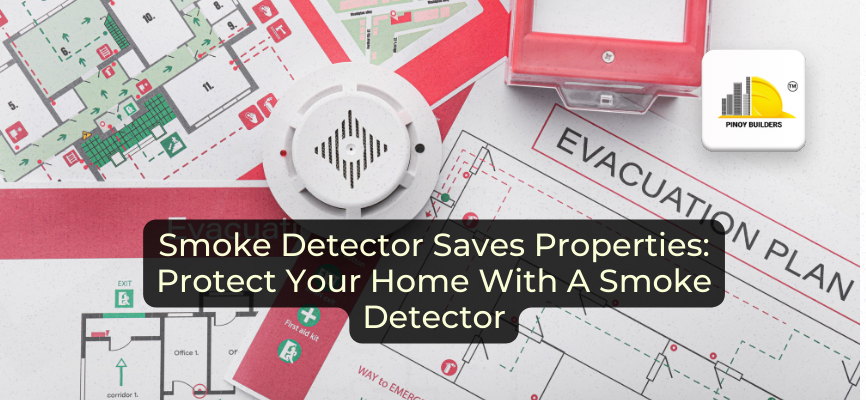Fire safety is always crucial in every structure. Be it residential or commercial, it is important to ensure that the building will stay prepared for any fire incidents that may occur. While knowing the basic steps and methods to apply in the instance of an emergency, having preventative measures that will help prevent a fire or the spread of one is a necessary approach that can be truly life-saving.
One of the most important tools used in fire safety is smoke detectors. Smoke detectors are required to be installed in every commercial structure built in the Philippines. While they are not required to be installed in all residential spaces, they have indispensable advantages to the responsible homeowner. In this article, we will discuss the importance of smoke detectors in fire safety. We will also discuss the types of smoke detectors, their differences, and which one is best fit for each type of building.
Protect Your Home With A Smoke Detector

Smoke detectors are important fire protection devices that help indicate the presence of smoke—one of the key indicators of fire. Once the device detects smoke, it will set off an alarm that will immediately alert the occupants and authorities of a building to immediately perform fire safety methods—such as evacuating the area or conducting fire extinguishing techniques.
Smoke detectors are vital for early fire detection. They significantly increase the chances of safe evacuation and minimizing property damage. They are often a required safety feature in building codes and regulations worldwide due to their proven effectiveness in saving lives. In the 2008 Revised Fire Code of the Philippines or Republic Act No. 9514, safety warning systems such as smoke detectors are required to be installed in every commercial building
Types of Smoke Detectors
1. Ionization Smoke Detectors
Ionization smoke detectors have a small amount of radioactive material between two electrically charged plates, which ionizes the air and creates a current flow. When smoke enters the chamber, it disrupts this ionization process, reducing the current and triggering the alarm. Ionization smoke detectors detect smoke produced by fast-flaming fires.
2. Photoelectric Smoke Detectors
Photoelectric smoke detectors use a light source and a light sensor positioned at an angle to each other. When smoke enters the chamber, it scatters the light, directing it toward the sensor and triggering the alarm. Photoelectric smoke detectors better detect smoke particles that are typically produced by smoldering, slow-burning fires.
3. Dual-Sensor Smoke Detectors
A dual-sensor smoke detector is a type of smoke alarm that incorporates two different technologies to detect the presence of smoke or fire. These detectors combine ionization and photoelectric sensors to offer more comprehensive protection by responding to a wider range of fire types. Dual smoke detectors can detect both fast-flaming and smoldering fires.
4. Aspirating Smoke Detectors (ASDs)
An Aspirating Smoke Detector (ASD) is a highly sensitive smoke detection device used primarily in environments where early fire detection is crucial. It works by continuously sampling air from the protected area through a network of pipes. This type of smoke detector is best suited for environments where traditional smoke detectors might not be as effective, and early smoke detection is critical such as:
- Warehouses
- Museums Art Galleries
- Servier rooms
- Laboratories and other contaminant-free spaces
- Data centers
- Server rooms
The Importance of Smoke Detectors According to the Fire Code of the Philippines
The Fire Code mandates the installation of fire detection and alarm systems in various types of buildings to ensure the safety of occupants and property. It enforces the installation of smoke detectors in specified types of buildings which may include residential, commercial, and public structures. These regulations are in place to enhance fire safety and ensure the early detection of fires, thus protecting lives and property. Regular inspections and compliance with these requirements are crucial for maintaining safety standards.
There are quite a few specifications dictated by the Fire Code when it comes to installing smoke detectors such as:

- To ensure safety during a fire, the building must have smoke detectors installed near the entrance of smokeproof stairwells (within about 10 feet).
- According to the Fire Code, when a full smoke detection system is needed to be installed in the building, automatic smoke detectors must be installed in all areas where people are. This includes common and work areas, as long as those places are suitable for smoke detectors.
- If the only way to exit a room is by passing through another room, smoke detectors must be installed in the shared space between the two rooms.
- All corridors in hospitals, nursing homes, and residential care facilities must have approved automatic heat and/or smoke detection systems. These systems should follow NFPA 72 (National Fire Alarm and Signaling Code) standards. Smoke detectors must be no more than 9 meters apart and no more than 4.6 meters from any wall. All detection systems must be electrically connected to the fire alarm system.
- Smoke detectors shall not be required in sleeping rooms with four or fewer occupants.
Fire Safety: Installing Smoke Detectors For Fire Protection
Smoke detectors play a critical role in ensuring home safety by providing early warnings of fire, which can save lives and minimize property damage. Investing in high-quality smoke detectors and maintaining them regularly is essential for optimal performance. Readers are encouraged to prioritize the installation and upkeep of these devices, as their life-saving potential cannot be overstated.
Beyond their practical benefits, smoke detectors are also a legal requirement in many areas—a fact that underscores their importance in your safety. Protect your home and loved ones by ensuring that smoke detectors are properly installed and maintained, fulfilling both a legal and moral responsibility.
References
BFP. (n.d.). RA 9514: The Fire Code of the Philippines , Revised 2019. BFP. Retrieved May 20, 2024, from https://bfp.gov.ph/wp-content/uploads/2019/10/RA9514-RIRR-rev-2019.pdf
Blaze Guard. (n.d.). Types Of Smoke Detectors And Their Differences. Blaze Guard. Retrieved May 20, 2024, from https://www.yourblazeguard.com/types-of-smoke-detectors-and-their-differences/
First Alert. (n.d.). What is a Dual Sensor Smoke Alarm? | Dual Sensor Smoke Detector w/ 10-Year Battery. First Alert. Retrieved May 20, 2024, from https://www.firstalert.com/us/en/safetycorner/dual-sensor-home-smoke-alarms-first-alert-10-year-battery/
IFSEC Insider. (n.d.). Smoke detectors explained. IFSEC Insider. Retrieved May 20, 2024, from https://www.ifsecglobal.com/smoke-detectors/
Industrial PH. (n.d.). Fire Detection and Alarm System Philippines. Industrial PH. Retrieved May 20, 2024, from https://industrial.ph/fire-detection-and-alarm-system-philippines/
Meiji Electric Philippines Inc. (2019, June 20). Where to Place Your Smoke Detectors In Your Home Or Workplace. Meiji Electric Philippines Inc. Retrieved May 20, 2024, from https://meijielectric.ph/place-smoke-detectors-home-workplace/
Strongsville. (n.d.). IMPORTANCE OF SMOKE DETECTORS FIRE SAFETY THE EFFECTS OF DEADLY SMOKE AND POISONOUS GASES PLAN YOUR ESCAPE BEDROOM SAFETY &am. Strongsville. Retrieved May 20, 2024, from https://www.strongsville.org/CityOfStrongsville/media/StrongsvilleMedia/Documents/Home-Fire-Safety-Guide.pdf
Wikipedia. (n.d.). Aspirating smoke detector. Wikipedia. Retrieved May 20, 2024, from https://en.wikipedia.org/wiki/Aspirating_smoke_detector










